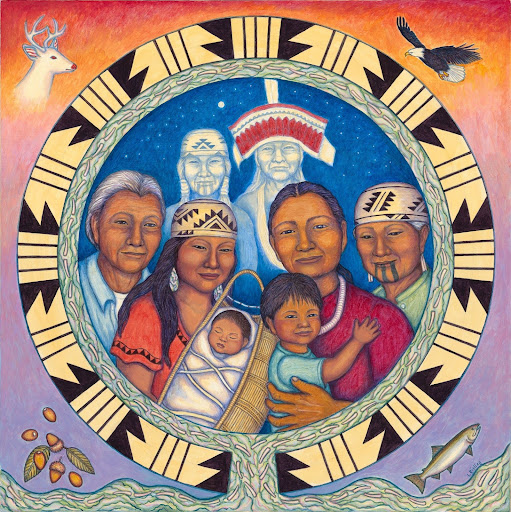Overview
We are Still Here: History and Survival

Authors and Collaborators:
Maggie Peters, Yurok/Karuk Educator, Traditional Basket Weaver, Cultural Preservationist, Native American Studies Model Curriculum Learning Specialist at Humboldt County Office of Education
Lyn Risling, Karuk/Yurok/Hupa Artist, Author, Illustrator, Ceremonial Leader
Julian Lang, Karuk Linguist, Artist
- Video support provided by Joanna Galicha, Graphics & Communications Specialist at Humboldt County Office of Education
We Are Still Here, Fix the World People Unit (Lesson 3 of 6)
- Lesson 1: Notice Wonder Feel
- Lesson 2: Lyn Risling, Karuk, Hupa, and Yurok Artist
- Lesson 3: History and Survival
- Lesson 4: Resilience and Healing
- Lesson 5: Ararachúupha Nuu Payêem Nuchúuphitih (We Are Talking Our Indian Language Now)
- Lesson 6: Expression of Self - Art Inspired by Lyn Risling
Grade: 7
Suggested Amount of Time: 55- 60 minutes (designed for multi-period schedule typical of middle schools)
Curriculum Themes
- History
- Cultural Strengths
- Relationship to Place
- Cross Curricular Integration
Learning Goals
- Identify Indigenous groups in Northwest California.
- Understand some of the history of colonization in Northwestern California.
- Recognize the impacts of colonization to Indigenous populations.
- Develop empathy and consider a role in advocating for Indigenous Peoples and protection of Indigenous rights today.
Lesson Overview
In this third lesson of the “We Are Still Here, Fix the World People” Unit, students will explore the colonial impacts of genocide on Indigenous peoples of Northwest California, focusing on the events surrounding the Gold Rush, the timber industry, indentured servitude and boarding schools. The central resource for this lesson will be the United Indian Health Services video, "History and Hope", which provides a powerful narrative of the suffering of Indigenous communities during this tumultuous period. Through this video, students will learn about the violence and displacement Indigenous peoples faced during the Gold Rush, where settler colonialism, greed for resources, and racial ideologies led to devastating consequences.
The lesson will begin with a viewing of the History and Hope video, followed by a class discussion on the various forms of exploitation and violence faced by Indigenous groups, such as massacres, forced enslavement, and the destruction of their land and culture. After viewing the video and engaging in discussion, students will reflect on the emotional and social impacts of these historical events. Students will also engage in group discussions to explore the concept of genocide.
By the end of the lesson, students will have a deeper understanding of the colonial forces that shaped the history of Indigenous peoples in Northwest California and the lasting effects of these historical traumas. They will be encouraged to think critically about their role in advocating for justice, equality, and healing in Indigenous communities today.
Teacher Background
Teaching about the genocide of Indigenous peoples, particularly in the context of California's Gold Rush and other colonial impacts, is an important responsibility. This topic involves painful history, complex issues, and sensitive emotional content. Approach this topic with care, empathy, and a commitment to creating a safe and respectful learning environment.
Build a Safe and Respectful Learning Environment. Students need to feel comfortable discussing sensitive issues. Reinforce your classroom expectations for respectful listening, speaking, and acknowledging differing opinions. Be mindful that some students may have personal connections to Indigenous histories, and the content may trigger strong emotions. Encourage empathy, active listening, and open dialogue.
Prepare for Emotional Responses. Learning about genocide and historical trauma can provoke a range of emotional responses, from sadness to anger or disbelief. This lesson will provide opportunities for students to express their feelings through journaling, partner discussions, and class reflections. Be prepared to guide students through difficult emotions, helping them understand the historical context without fostering a sense of helplessness.
It’s important to emphasize resilience and hope, especially when discussing Indigenous survival and efforts toward cultural revival. By focusing on the strength of Indigenous communities, students can develop a more balanced perspective on both historical pain and present-day recovery.
Use Diverse, Accurate, and Culturally Respectful Resources. When teaching about Indigenous genocide, it’s crucial to use materials that accurately reflect the experiences of Indigenous peoples. The United Indian Health Services video "History and Hope" is a powerful resource that provides historical context and insights from Indigenous perspectives. It’s important to critically assess the resources you use, ensuring they are not romanticized or oversimplified but are rooted in historical facts and the voices of Indigenous people.
Emphasize Historical Context and Systems of Power. Help students understand that the genocide of Indigenous peoples didn’t occur in isolation but was part of broader patterns of settler colonialism. Students will be introduced to systems of power and ideology that enabled the exploitation and destruction of Indigenous communities, including the role of the Gold Rush, the timber industry, indentured servitude, and government policies like the establishment of boarding schools. Students will reflect about the ways in which these systems sought to erase Indigenous cultures, resources, and identities. By framing the genocide as part of ongoing colonial processes, students will better understand how these historical injustices continue to affect Indigenous communities today.
Encourage Critical Reflection and Action. After presenting the video and slides, students will reflect on the impacts of the genocide and consider ways to support Indigenous communities today. Guide them in thinking about social justice, human rights, and reconciliation. Reflection activities should not only help students process the historical content but also prompt them to consider their role in advocating for Indigenous rights and healing in contemporary society.

